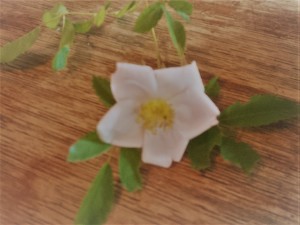
Rosa laevigata, has acquired a host of nicknames over its long history, but is most often called “the Cherokee rose”. It is native to China, but has been in North America so long and acclimated so well that many people think of it as an indiginous wildflower.
Its longevity and popularity is also due to its beauty, which has been celebrated in lore and legend. The flowers are big, as wild roses go, spreading about 3.5 inches in diameter, with four to eight pure white petals surrounding a fat boss of golden stamens. Borne singly, as opposed to the cluster-flowered configuration of many wild roses, Cherokee rose blooms appear in late spring or early summer. The flowers resemble camellias, giving rise to a secondary common name, “Camellia rose”. Glossy, dark green leaves sprout in clusters of three, five, or occasionally seven. Like most species roses, the Cherokee rose blooms only once every growing season, but a vigorous, mature shrub may bear scores of lightly fragrant blooms, which are succeeded by decorative red hips. The canes tend to sprawl, but the plant can also be grown as a climber to save space.
Like so many good things, Rosa laevigata has a liability—prickles. The stems are loaded with plenty of thorns, which protect the plant from human and animal predators, but may discourage some gardeners. I think the shrub more than compensates for its prickly nature.
The name “Cherokee rose” is derived from a legend laden with a number of variations, but similar basic elements. In 1838, the United States government forced the resettlement of the Cherokee Nation from its home region in Georgia and adjacent states to what is now the state of Oklahoma, a journey of about 2,200 miles. According to some sources, 15,000 or more members of the Cherokee Nation began the march in 1838 and at least 4,000 died on the arduous journey. The toll was so heavy and the grief of the uprooted Cherokee so profound that the westward route became known as “the trail of tears.”
Rosa laevigata, which had grown on Cherokee properties in Georgia, also grew along the westward route and, according to legend, served as a symbol of hope and inspiration to the Cherokee as they struggled towards their new home. One variation of the story suggests that Cherokee tears fell to earth causing the roses to sprout where the tears landed.
It may be somewhat ironic that since 1916, the Cherokee rose has been the official State Flower of Georgia.
There is no concrete evidence of how and when Rosa laevigata arrived in the United States. Garden historian Denise Wyles Adams, in her wonderful book, Restoring American Gardens, notes that Rosa laevigata was introduced in the United States in 1759. The rose caught on quickly and escaped gardens readily. Pioneering French botanist Andre Michaux saw the shrubs growing wild in Georgia and described them in his book Flora Boreali-Americana, published in 1803. In 1804, avid gardener Thomas Jefferson planted seeds of Rosa laevigata at Monticello.
Over time, the rose was also used in breeding. Luther Burbank produced a light pink, cluster-flowered hybrid that he called ‘Garland’ in 1918. ‘Ramona’, sometimes known as ‘Red Cherokee’ was a sport or spontaneous genetic mutation of another hybrid, the light pink ‘Anemone’.
Cherokee rose is heat tolerant and disease resistant, but is somewhat susceptible to cold. It is hardy only to USDA Zone 7, which means that it can stand some winter temperatures, but will not survive in places where the average minimum winter temperature goes below 10 degrees Fahrenheit. In Zone 7, I would plant it in a protected spot and mulch it well during the winter.
If you live in a climate that supports the Cherokee rose, it is useful as a boundary or barrier hedge. Grown on its own, it will form a five-foot mound, but trained up an arbor or trellis, it will rise to 15 feet or more. It is easily kept in check by pruning, which is best done just after flowering. Unlike some other rambunctious species roses, it does not produce annoying root suckers.
The Cherokee rose, with its long history and sometimes tragic associations is still available today from some heirloom rose purveyors. It is currently in the inventory of The Antique Rose Emporium, 9300 Lueckemeyer Rd., Brenham, TX 77833; 800-441-0002 or 979-836-9051; roses@weareroses.com.
